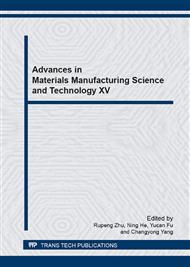p.69
p.74
p.78
p.84
p.89
p.95
p.100
p.106
p.110
The Multi-Objective Optimization on Milling Parameters of Ultra-High Strength Steel 30Cr3SiNiMoVA
Abstract:
Ultra-high strength steel 30Cr3SiNiMoVA has excellent mechanical properties, including high strength and hardness, a certain degree of ductility and toughness. The superior properties have awarded a wide application of 30Cr3SiNiMoVA in the aviation industry. But on the other hand, The ultra-high strength steel 30Cr3SiNiMoVA is a typically difficult-to-cut material, The difficult-to-cut features in the process of which include high cutting temperature and cutting force, severe tool wear, low productivity and so on. So selection of appropriate cutting parameters is very important in the process. In this paper, high-speed milling tests were carried out, to investigate the performance of 30Cr3SiNiMoVA under given conditions. Basing on the results of the experiments, Empirical formulas of surface roughness and cutting force were got. Finally, the multi-objective optimization on cutting parameters was conducted. The optimized parameters in the test conditions were ap=10mm, V=50/min, fz=0.06mm/z, aw=0.4mm.
Info:
Periodical:
Pages:
89-94
Citation:
Online since:
October 2013
Authors:
Keywords:
Price:
Сopyright:
© 2014 Trans Tech Publications Ltd. All Rights Reserved
Share:
Citation:


